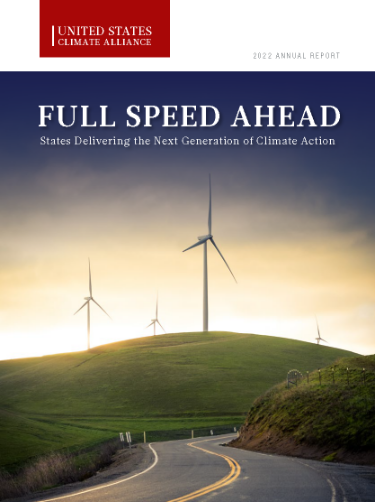Home / U.S. Climate Alliance 2022 Annual Report Finds Its States Pollute Less, Save More Energy, and Employ More Clean Energy Workers Than Rest of Country

WASHINGTON, D.C. – The bipartisan U.S. Climate Alliance today released its annual report, Full Speed Ahead: States Delivering the Next Generation of Climate Action, which finds that its 24 states and territories — representing 58% of the U.S. economy and 54% of the U.S. population — are tackling climate change while achieving lower levels of harmful local air pollution, delivering more energy savings to homes and businesses, employing more clean energy workers, preparing more effectively for climate impacts and disasters, and generating a higher proportion of electricity from zero-carbon sources than the rest of the country.
“It’s no coincidence that the air is cleaner, household and business energy savings are higher, and clean energy jobs are more abundant across Alliance states,” said the Alliance’s co-chairs New York Gov. Kathy Hochul, Washington Gov. Jay Inslee, and California Gov. Gavin Newsom in their Annual Report message. “Day in and day out we are showing the power of state climate action and proving that together, we can make real progress.”
The Annual Report details how Alliance states are moving beyond foundational climate policies to advance the next generation of innovative, high-impact, state-led climate actions that will result in even more significant reductions of greenhouse gas emissions — all while building just, equitable, and climate-resilient infrastructure, ecosystems, and communities. In fact, over the past year, Alliance states have pushed dozens of new laws and programs to: strengthen GHG targets, reduce the climate impact of buildings and emissions from the oil and gas sector, accelerate vehicle electrification, and expand and guide state resilience and environmental justice actions, among many other measures. This bold, sustained action ensures the U.S. continues to move closer to its climate goals, regardless of political and legal uncertainty at the federal level.
While taking increasingly ambitious and impactful climate action, Alliance states continue to deliver more environmental and economic benefits to their residents and businesses than the rest of the U.S. Specifically, the Annual Report finds that Alliance states generate just half of the levels of criteria air pollutants per capita, on average, and collectively employ over 40% more workers in the renewable energy and energy efficiency sectors than non-Alliance states.
The report also finds that utility energy efficiency programs across Alliance states saved a cumulative 1.5 megawatt-hours (MWh) of electricity per capita over the lifetime of these programs compared to 0.65 MWh per capita in the rest of the U.S. as of 2020. Meanwhile, Alliance states are preparing more effectively for climate impacts and disasters, producing far more adaptation and resilience plans than non-Alliance states. Finally, Alliance states are generating a higher proportion of electricity from zero-carbon sources than the rest of the country with non-Alliance states generating three times as much electricity from coal (581 TWh vs. 192 TWh) and 1.5 times as much from natural gas (964 TWh vs. 660 TWh) in 2020.
As the Alliance celebrates its fifth anniversary in 2022, the report notes how this coalition continues to strengthen and expand the state-federal partnership. In addition to helping secure passage of the Inflation Reduction Act — and committing to using every tool available to deliver on the promise of this law — Alliance states and governors are working with the Biden Administration to strengthen federal programs, regulations and tools and exchanging expertise to inform action, boost equity and grow state-level leadership on climate.
The full Annual Report and Executive Summary can be read here.
Launched on June 1, 2017 by the governors of Washington, New York, and California to help fill the void left by the previous administration’s decision to withdraw the U.S. from the Paris Agreement, the Alliance has grown to include 24 governors from across the U.S. representing approximately 60% of the U.S. economy and 55% of the U.S. population. Governors in the Alliance have pledged to collectively reduce net greenhouse gas emissions by at least 26-28% by 2025, 50-52% by 2030, and 61-66% by 2035, all below 2005 levels, and collectively achieve overall net-zero greenhouse gas emissions as soon as practicable, and no later than 2050.
The Alliance’s states and territories continue to demonstrate that climate action goes hand-in-hand with economic growth, job creation, and better public health. The Alliance reduced its collective net greenhouse gas emissions by 19% between 2005 and 2022, while increasing collective GDP by 30%, and is on track to meet its near-term climate goal by reducing collective GHG emissions 26% below 2005 levels by 2025. The coalition’s states and territories are employing more workers in the clean energy sector, achieving lower levels of dangerous air pollutants, and preparing more effectively for climate impacts and executing more pre-disaster planning than the rest of the country.
###